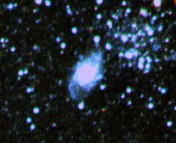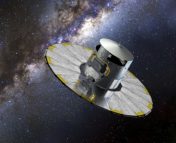Title: Identification of the Long Stellar Stream of the Prototypical Massive Globular Cluster ω Centauri
Authors: Rodrigo Ibata, Michele Bellazzini, Khyati Malhan, Nicolas Martin, Paolo Bianchini
First Author’s Institution: Observatoire Astronomique, Université de Strasbourg, CNRS, Strasbourg, France
Status: Accepted for publication in Nature, open access on arXiv
“The discovery of a new dish confers more happiness on humanity, than the discovery of a new star” goes a saying by the famous French food philosopher Jean Anthelme Brillat-Savarin. I confess that, even as an astronomer, I find it hard to refute this claim. But some astronomical discoveries provide so much food (for thought), that I wonder if Brillat-Savarin could have been convinced to broaden his definition of a dish. Today’s paper, for example, demonstrates that there are few things in the world that make a person who studies galactic dynamics as happy as the discovery of a new stellar stream.
Stellar streams are the by-products of violent interactions between a galaxy and a smaller passer-by, typically a dwarf galaxy or a globular cluster. And though stellar streams have been observed around many other galaxies, we need look no further than our own Milky Way to see some truly majestic stream-like structures (as shown Figure 1).

Figure 1. The “Field of Streams” image of the Milky Way, including some of the most prominent streams around our Galaxy. The white circles mark additional globular clusters and dwarf galaxies that have not yet been fully disrupted by the Milky Way (credit: V. Belokurov and SDSS).
When the Milky Way’s gravity separates a star from its parent globular cluster, the star gets placed on a nearly identical orbit, just a little bit ahead or a little bit behind the progenitor itself. As the process continues, two long and thin ‘arms’ of stars form on either side of the original cluster, one leading the cluster and the other trailing it. And because of their formation mechanism, these two arms trace out almost exactly the orbital path that the original cluster was on.
Why, then, does a stellar stream confer so much happiness on galactic dynamicists? One of the main aims of galactic dynamics is to study the gravitational potential of the Milky Way. In general, the most straightforward way to figure out an object’s gravitational potential is to study its mass distribution, but unfortunately this doesn’t help because our Galaxy is made mostly of invisible Dark Matter (in fact, another reason people would like to know the Milky Way’s galactic potential is to reverse engineer this argument in order to understand the mass, shape, and nature of our Dark Matter Halo). Another great way of inferring the Galactic potential is to observe how stars orbit the Galaxy — similar to the way that we can use the motion of the planets around the Sun to infer the Sun’s mass. But unlike planets in our Solar System, it takes many millions of years for a star to orbit the Galaxy once, and astronomers are obviously too impatient to wait that long.
This is exactly where stellar streams come in. By observing the location of a stream’s leading and trailing arms, astronomers can see a full section of the progenitor’s orbit, and essentially circumvent millions of years worth of work! So it’s no wonder that these streams make galactic dynamicists so happy.
But in order to learn anything from stellar streams, we first have to find them, and that is not always a straightforward task. Historically, stellar streams were found by visually searching the sky for stream-like structures. More recently, stream-hunters have looked in the vicinity of globular clusters to try and find their leading and trailing arms. Yet, both of these methods lead to significant difficulties when looking in crowded parts of the sky, especially as one gets closer to the Galactic center. Today’s authors have taken a slightly different approach: in a series of papers over the past year, they successfully identified 14 new streams around the Milky Way, by applying an algorithm they created called STREAMFINDER to the recently released kinematic data from the Gaia satellite (Gaia DR2). STREAMFINDER carefully evaluates the individual orbits of stars and finds groups that are likely to be kinematically associated with each other as part of a stellar stream.
In a paper published two months ago, the authors reported the discovery of eight new stellar streams using STREAMFINDER, seen in Figure 2. Just to reiterate, the discovery of a single stream is typically reason enough for publishing a paper, so discovering eight at once is truly a remarkable feat! The newly discovered streams were named after the “ice rivers,” or Élivágar of Norse Mythology: Slidr, Sylgr, Ylgr, Fimbulthul, Svöl, Fjörm, Gjöll, and Leiptr (according to the Edda, these are eight of the eleven rivers that were said to exist near “Ginnungagap,” the Primordial Void or the Gaping Abyss, which existed at the dawn of time).

Figure 2. “The streams of the Gaping Abyss” as reported in this group’s previous paper from 2019. The x- and y-axis mark the galactic longitude and latitude, and the color scale indicates the stars’ angular momentum around the Galaxy’s vertical axis (one of the panels in Figure 6 from Ibata et al. 2019a).
Of these eight streams, the authors found Fimbulthul to be particularly fascinating. Today’s paper is devoted to studying this stream in detail, and zeroing in on its likely progenitor, the globular cluster ω Centauri (aka ω Cen). The reason the authors (and many other researchers in the field) found this to be so exciting is that ω Cen is the single largest globular cluster known to orbit our Galaxy. In fact, it is so large that many believe it to be the core of an even larger dwarf galaxy that was tidally disrupted by our Galaxy. However, for this scenario to be true, one would expect to find tidally disrupted debris forming a stream-like structure originating from ω Cen, yet nothing had been found — until Fimbulthul.
In today’s paper, the authors extended many of their findings from the previous paper to further strengthen their claim that Fimbulthul is indeed the long-awaited tidal stream of ω Cen:
1. They performed a detailed comparison between Fimbulthul’s structure and the orbital path of ω Cen, showing that they are consistent with each other (see Figure 3).
2. They ran an N-body simulation to model the tidal disruption of ω Cen by the Milky Way, and were able to demonstrate that the observed distribution of stars in Fimbulthul closely matches that of their N-body simulation.
3. They performed detailed follow-up spectroscopic observations of 5 stars in the Fimbulthul structure using the CFHT (the 3.6 meter Canada-France-Hawaii Telescope located in Mauna Kea, Hawaii), which they used both to confirm the original Gaia data, and to show that the metallicities of the stars are consistent with the metallicities of the stellar population of ω Cen.

Figure 3. Each panel shows one component of the Fimbulthul Stream stars’ proper motion (measured in milliarcseconds per year) against their galactic longitude. The red marks and error bars mark the observed locations of the Fimbulthul stars, while the blue dots are based on the authors’ N-body simulation of the stream. The dotted line indicates the best fit orbit for the observed stars, while the solid line indicates the orbit of ω Cen that was used to create the N-body simulation (second and third panels from Figure 1 in the paper).
With this in hand, the authors went one step further. By combining the kinematic data from their N-body simulation and the color-magnitude distribution of the stars associated with Fimbulthul and ω Cen, the authors filtered the area surrounding ω Cen and Fimbulthul to try and identify additional members of the stream. Using this filter, they were able to find for the first time a clear stream-like structure emanating from ω Cen, as seen in Figure 4.

Figure 4. ω Cen and surrounding stars that were tidally stripped away from the globular cluster, based on the stellar properties and kinematics that resemble ω Cen and Fimbulthul. Note the clear stream-like structure emanating from the globular cluster. The panel on the right shows the same image with particles from the N-body model and the Fimbulthul stars superposed (Figure 4 in the paper).
With a confirmed detection of ω Cen’s stream, there is much more science to get excited about. In particular, studying the Fimbulthul stream could shed more light on the interaction between the Milky Way and the dwarf galaxy whose stellar core turned into ω Cen. These kinds of processes are central to the evolution of galaxies, so seeing their remnants and studying them is one of the most direct ways of understanding how our Galaxy came to look like it does today. In short, new streams make for exciting times!




